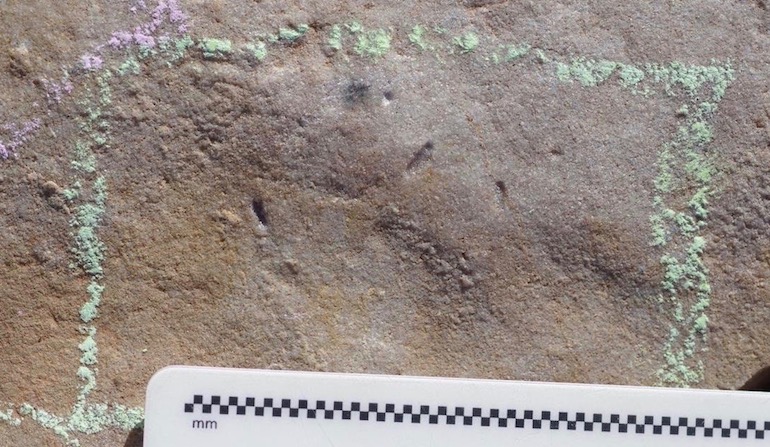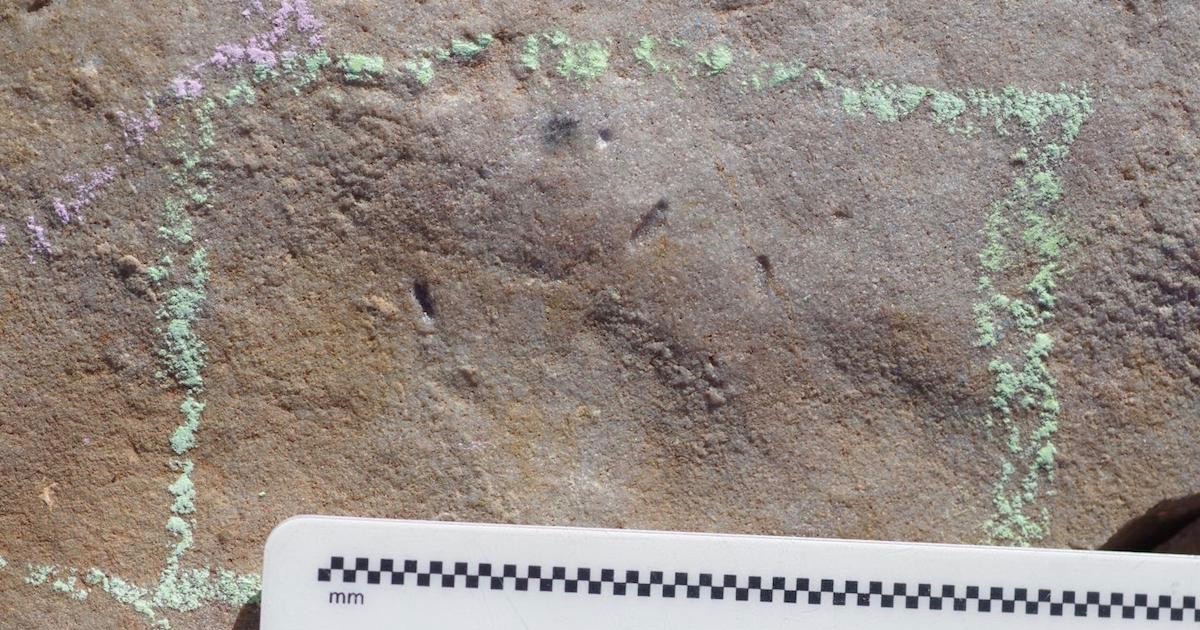 Evolution
Evolution
Ancestor of All Animals in 555-Million-Year-Old Ediacaran Sediments?


For my series of articles about alleged Ediacaran animals predating the Cambrian explosion there is a new candidate that deserves a closer view: New research on Ediacaran fossils was just published in the Proceedings of the National Academy of Sciences by a team of scientists from UC Riverside (Evans et al. 2020), and it has already made global news headlines including, “Ancestor of all animals identified in Australian fossils” (University of California 2020) and the even more sensational, “Fossil hunters find evidence of 555m-year-old human relative” (Davis 2020). What did those scientists discover and are their far-reaching conclusions really justified?
Grains of Rice
The authors of this study looked at fossil layers from the National Heritage Nilpena site in the Flinders Range of South Australia, which are slightly older than those layers that yielded the typical Ediacaran macrofossils. These 555-million-year-old layers were well-known for abundant trace fossils, especially of the Helminthoidichnites type. Together with such trace fossils they discovered small oval impressions of a few millimeters in length, similar in size and shape to grains of rice. The researchers used 3-D laser scanning to study these impressions and found that they typically have a narrower end and a broader end. Because of this anterior-posterior differentiation and the (albeit rare) association with the fossil traces, the scientists considered the oval impressions to be bilaterian worms and the makers of the Helminthoidichnites traces. Since the trace making would imply muscular mobility and sediment displacement through mouth, gut, and anus, they inferred these bilaterian features, even though they are not preserved. They named the new taxon Ikaria wariootia after the names for the type locality in the Australian Aboriginal language. The authors speculate that Ikaria is as small and simple as it would have to be expected for a putative ancestor of bilaterian animals.
The associated unbranched meandering grooves called Helminthoidichnites are one of the most common trace fossils from the Ediacaran locality in South Australia, but with a cosmopolitan distribution at other localities of Ediacaran age, often associated with wrinkle marks of microbial mats (Gehling & Droser 2018).
Evans et al. (2020) mention that a statistical test of the size range of the Helminthoidichnites traces and Ikaria body fossils revealed a significant correlation beyond chance. However, this only means that both were caused by an organism of similar size and growth pattern, which if applied to recent biota would result in a flood of misidentifications. At best this allows the conclusion that the size of Ikaria would not contradict its identification as originator of the Helminthoidichnites traces, if this were supported by other evidence. Is it? Actually, there is a strong hint that Ikaria is not the maker of these traces. If it were, we should expect to at least occasionally find Ikaria in or at the end of these traces. However, the authors have studied 606 specimens of Helminthoidichnites and 127 specimens of Ikaria but did not find a single instance of such a direct association. They are quite aware of the problem and try to explain it away, with the claim that we should only find this association in those rare cases where Ikaria died in its trace, and also that it would be impossible to recognize the imprint of Ikaria in the furrow of the trace.
A Special Name — “Mortichnia”
However, instances of trace-makers that died within their trace are far from unknown in paleontology and even have a special name “mortichnia.” A famous example are the mortichnial trackways of horseshoe crabs in Upper Jurassic limestones from Germany (Lomax & Racay 2012), or the recent discovery of the mortichnia of another alleged Ediacaran worm Yilingia spiciformis from southern China (Chen et al. 2019, Sullivan 2019). Furthermore, if we compare the impressions of Ikaria with the preserved Helminthoidichnites traces on the same slabs, it is quite obvious that they would still be distinct and recognizable if superimposed with the traces. Therefore, the ad hoc explanation of the authors fails to explain the lack of any direct association. Actually, the problem is even more acute if we look at the taphonomy (generation and fossilization) of the Helminthoidichnites traces. They are considered to be horizontal burrows along the seafloor, immediately beneath the bacterial mats (“under-mat-miners”) that typically covered the Ediacaran sea floor (Fedonkin et al. 2007, Gehling & Droser 2018). Since Ikaria is preserved on the same sedimentological bed it seems obvious that they had to leave traces if they are preserved beneath the bacterial mats. Where are those traces and how did the “animals” get there? This is even evidence against a crawling activity of Ikaria.
Evidence for Bilaterian Burrowing?
Irrespective of whether or not Ikaria did make the Helminthoidichnites traces, one could ask if those traces are not themselves powerful evidence for bilaterian burrowing activity as some authors previously suspected (Narbonne 2005, Fedonkin et al. 2007, Gehling & Droser 2018)? The answer is: Not really, because the Helminthoidichnites could indeed be, not animal traces at all, but simply inorganic artifacts. The latter possibility was experimentally demonstrated for most Ediacaran “traces” (including traces very similar to Helminthoidichnites) by Mariotti et al. (2016), who found that these traces could be exactly reproduced as folding and shrinking artifacts of stirred up bacterial mats. Even if Helminthoidichnites should be a genuine burrowing trace of an organism, and even if Ikaria should be that organism, I suggest that it belonged either to giant protists that even today can cause such traces on the sea floor (Matz et al. 2008), or to an extinct specialized branch of the typical Ediacaran organisms of the coelenterate (cnidarian) grade, which independently acquired a worm-like habitus and burrowing lifestyle. After all, we know that the coelenterate body plan dominated the Ediacaran fauna and might readily have filled the free niche of marine worms.
Lo and Behold
But is invoking a potential worm-like cnidarian a plausible alternative? After all you could postulate all kinds of unknown organisms as ad hoc explanations. Therefore, this alternative would only have merit if we really knew that worm-like body plans exist among cnidarians. Lo and behold, they do. On the one hand, cnidarians have bilateral symmetric worm-like planula larvae, of which some (like those of Scyphozoa) are creeping over the substrate. But there is more: An enigmatic endoparasitic worm called Buddenbrockia plumatellae was for a long time a mystery and could not be placed in the animal system. In the past decades evidence accumulated that it could be a myxozoan cnidarian, which was finally confirmed by Jiménez-Guri et al. (2007). In the abstract of their paper, “Buddenbrockia Is a Cnidarian Worm,” these authors concluded: “This active muscular worm increases the known diversity in cnidarian body plans and demonstrates that a muscular, wormlike form can evolve in the absence of overt bilateral symmetry.”
In light of this discovery, unspecific worm-like fossils can no longer be considered as sufficient evidence for the presence of bilaterian animals (this by the way may also apply to Yilingia described by Chen et al. 2019, which has a unique body plan very different from annelids and arthropods). This is especially true when the fossils are so poorly preserved as Ikaria, lack any complex diagnostic features that could positively identify bilaterians, and have only a dubious association with alleged feeding traces.
In Search of a Sexy Headline
This does not mean that Ikaria could not be a potential bilaterian worm, but the case is far from established. Even if the attribution should turn out to be correct, the headlines — “Ancestor of all animals identified” — would be nonsense. Such hyperbole might be excused coming from ignorant popular science journalists, but that it was used in the official press release by the University of California is a shame. Nothing in this fossil discovery allows an identification as ancestor of any other group of animals or of all animals. Even being the oldest fossil record for Bilateria would not imply at all that it is ancestral to all animals. It could be an extinct side branch or only ancestral to a single phylum of worm-like animals. Evans et al. (2020) mention recent research that “suggests that the bilaterian LCA was a simple, small, mobile organism with anterior/posterior differentiation and limited sensory abilities (44–49). Remarkably, these predictions agree closely with the characters identified here for Ikaria.” However, such a simple worm-like habitus would fit with the ancestor of Bilateria, the ancestor of Xenacoelomorpha, the ancestor of Nephrozoa, the ancestors of Deuterostomia and of Protostomia, the ancestors of Lophotrochozoa and of Ecdysozoa, as well as the ancestors of several worm-like phyla like Platyhelminthes. But such scientific honesty would hardly make for a sexy headline.
Ikaria wariootia is just another problematic Ediacaran fossil that could be anything from inorganic artifact to protozoan to cnidarian and yes, maybe a bilaterian worm. Neither musculature, nor mouth, gut and anus, nor movement, nor mobility and a causal connection to the Helminthoidichnites traces is established by the actual fossil evidence. Its nothing but small oval-shaped impressions in the sediment. It is usually good paleontological practice to consider such dubious fossils as incertae sedis and not base far-reaching hypotheses on them.
References:
- Chen Z, Zhou C, Yuan X et al. 2019. Death march of a segmented and trilobate bilaterian elucidates early animal evolution. Nature 573, 412–415. DOI: 10.1038/s41586-019-1522-7.
- Davis N 2020. Fossil hunters find evidence of 555m-year-old human relative. The Guardian March 23, 2020.
- Evans SD, Hughes IV, Gehling JG & Droser ML 2020. Discovery of the oldest bilaterian from the Ediacaran of South Australia. PNAS 1–5. DOI: 10.1073/pnas.2001045117.
- Fedonkin MA, Gehling JG, Grey K, Narbonne GM & Vickers-Rich P 2008. The Rise of Animals: Evolution and Diversification of the Kingdom Animalia. John Hopkins University Press, 344 pp.
- Gehling JG & Droser ML 2018. Ediacaran scavenging as a prelude to predation. Emerging Topics in Life Sciences 2(2), 213–222. DOI: 10.1042/ETLS20170166.
- Jiménez-Guri E, Philippe H, Okamura B & Holland PWH 2007. Buddenbrockia is a Cnidarian Worm. Science 317(5834), 116–118. DOI: 10.1126/science.1142024.
- Lomax DR & Racay CA 2012. A Long Mortichnial Trackway of Mesolimulus walchi from the Upper Jurassic Solnhofen Lithographic Limestone near Wintershof, Germany. Ichnos 19(3), 175-183. DOI: 10.1080/10420940.2012.702704.
- Mariotti G, Pruss SB, Ai X, Perron JT & Bosak T 2016. Microbial origin of early animal trace fossils? Journal of Sedimentary Research 86, 287-293. DOI: 10.2110/jsr.2016.19.
- Matz MV, Frank TM, Marshall NJ, Widder EA & Johnsen S 2008. Giant Deep-Sea Protist Produces Bilaterian-like Traces. Current Biology 18(23), 1849-1854. DOI: 10.1016/j.cub.2008.10.028.
- Narbonne GM 2005. The Ediacara Biota: Neoproterozoic Origin of Animals and Their Ecosystems. Annual Review of Earth and Planetary Sciences 33, 421–442. DOI: 10.1146/annurev.earth.33.092203.122519.
- Sullivan H 2019. Behold Mortichnia, the Death Trail of an Ancient Worm. The New York Times September 4, 2019.
- University of California 2020. Ancestor of all animals identified in Australian fossils. Phys.org March 23, 2020.
Photo: Impressions of Ikaria, by Droser Lab/UCR, via EurekAlert!
